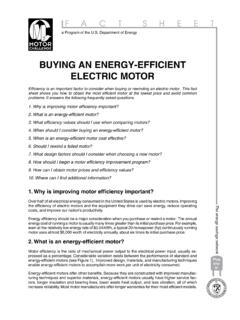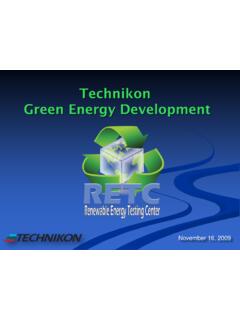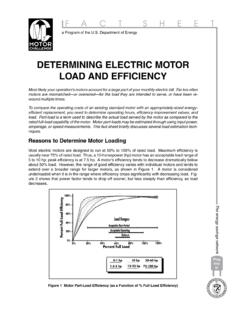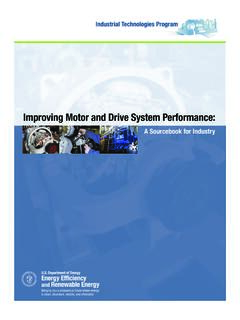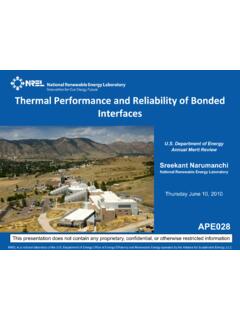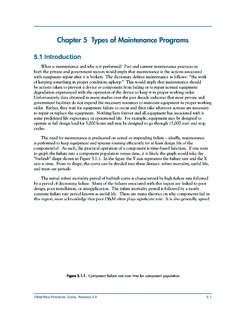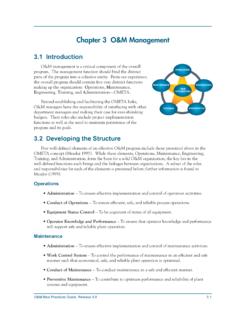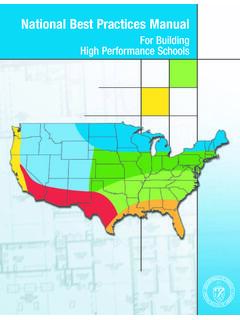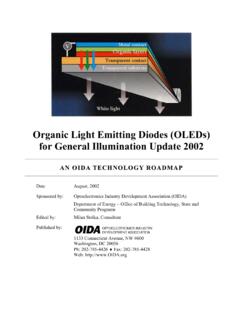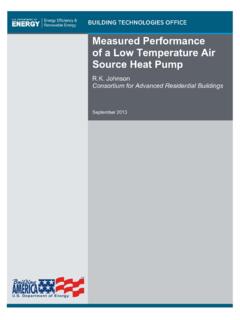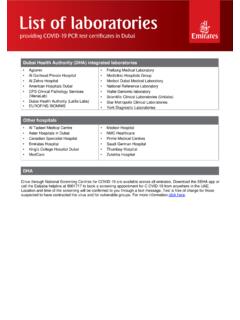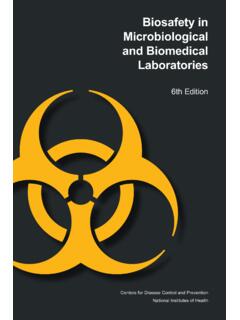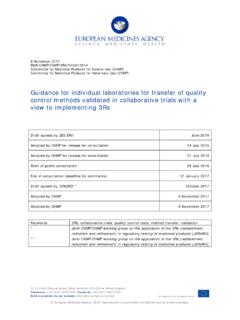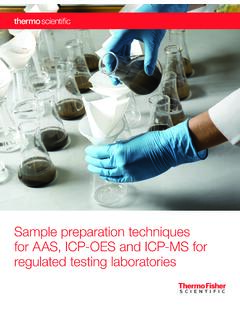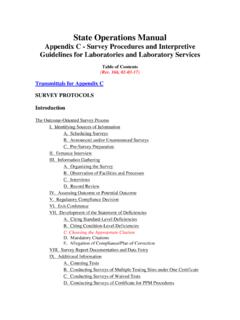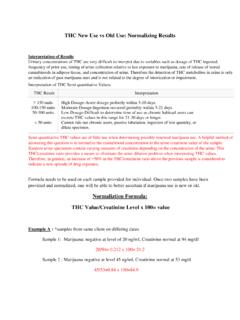Transcription of Handbook of Best Practices for Geothermal Drilling - Energy
1 SANDIA REPORT SAND2010-6048 Unlimited Release Printed December 2010 Handbook of Best Practices for Geothermal Drilling John Finger and Doug Blankenship Prepared by Sandia National laboratories Albuquerque, New Mexico 87185 and Livermore, California 94550 Sandia National laboratories is a multi-program laboratory managed and operated by Sandia Corporation, a wholly owned subsidiary of Lockheed Martin Corporation, for the Department of Energy s National Nuclear Security Administration under contract DE-AC04-94AL85000. Approved for public release; further dissemination unlimited. 2 Issued by Sandia National laboratories , operated for the United States Department of Energy by Sandia Corporation. NOTICE: This report was prepared as an account of work sponsored by an agency of the United States Government.
2 Neither the United States Government, nor any agency thereof, nor any of their employees, nor any of their contractors, subcontractors, or their employees, make any warranty, express or implied, or assume any legal liability or responsibility for the accuracy, completeness, or usefulness of any information, apparatus, product, or process disclosed, or represent that its use would not infringe privately owned rights. Reference herein to any specific commercial product, process, or service by trade name, trademark, manufacturer, or otherwise, does not necessarily constitute or imply its endorsement, recommendation, or favoring by the United States Government, any agency thereof, or any of their contractors or subcontractors. The views and opinions expressed herein do not necessarily state or reflect those of the United States Government, any agency thereof, or any of their contractors.
3 Printed in the United States of America. This report has been reproduced directly from the best available copy. Available to DOE and DOE contractors from Department of Energy Office of Scientific and Technical Information Box 62 Oak Ridge, TN 37831 Telephone: (865) 576-8401 Facsimile: (865) 576-5728 E-Mail: Online ordering: Available to the public from Department of Commerce National Technical Information Service 5285 Port Royal Rd. Springfield, VA 22161 Telephone: (800) 553-6847 Facsimile: (703) 605-6900 E-Mail: Online order: #online 3 SAND2010-6048 Unlimited Release Printed December 2010 Handbook of Best Practices for Geothermal Drilling John Finger and Doug Blankenship Prepared for the International Energy Agency, Geothermal Implementing Agreement, Annex VII by Sandia National laboratories Box 5800 Albuquerque, New Mexico 87185 Abstract This Handbook is a description of the complex process that comprises Drilling a Geothermal well.
4 The focus of the detailed Chapters covering various aspects of the process (casing design, cementing, logging and instrumentation, etc) is on techniques and hardware that have proven successful in Geothermal reservoirs around the world. The Handbook will eventually be linked to the Geothermal Implementing Agreement (GIA) web site, with the hope and expectation that it can be continually updated as new methods are demonstrated or proven. 4 Acknowledgements This Handbook was funded by the US Department of Energy s Geothermal Technologies Program and has been made possible with support and guidance from Jay Nathwani. The Handbook was prepared for the International Energy Agency, Geothermal Implementing Agreement, Annex VII. Drafts of the Handbook have been extensively reviewed, and the authors gratitude for extremely valuable comments is extended to Steve Pye, Lindsay Fooks ( Geothermal Associates NZ Ltd), and James Coda (Department of Primary Industries and Resources SA), as well as present and previous staff members Steve Bauer, David Raymond, Randy Normann, Steve Knudsen, Chip Mansure, Ron Jacobson, and Joe Henfling in the Geothermal Research Department at Sandia National laboratories .
5 5 Table of Contents Acknowledgements .. 4 1. Introduction to Geothermal Energy ..9 Occurrence of Geothermal Energy .. 9 Heat Flow and Temperature .. 10 Tectonic Controls .. 10 Types of Geothermal Systems .. 12 2. Overview of Geothermal Drilling ..13 Background .. 13 Approach in this Handbook .. 13 Nature of Geothermal Formations .. 14 Well Cost Drivers .. 15 Well design .. 16 Drilling Hazards .. 17 Rate of penetration (ROP) .. 17 Bit and tool 17 3. Planning a Geothermal Well ..18 Overview .. 18 Drill Rig Selection .. 20 Rig capacity .. 22 Rig footprint .. 22 Pump capacity .. 22 Fluid cleaning .. 23 Drill string and BHA .. 23 High-temperature capability .. 23 Rig instrumentation .. 23 Support .. 24 Crew and training .. 24 Case Histories of Two Geothermal Wells .. 24 Steam Well .. 24 Brine Well .. 24 4. Wellbore Design Casing and Cement.
6 26 Overview .. 26 Casing design .. 27 Cementing .. 29 Completions .. 31 5. Drilling Fluids ..33 Overview .. 33 Drilling fluid functions .. 34 Drilling fluid system .. 34 6 Planning the mud program .. 37 6. Drilling Tools ..38 Bits: .. 38 Other reasons for 40 Percussion Drilling .. 41 Drill pipe .. 42 Insulated drill pipe (IDP) .. 42 Dual-tube reverse circulation (DTRC).. 43 Bottom-hole assembly (BHA) .. 44 Directional Drilling .. 46 7. Potential Problems ..48 Lost circulation .. 48 Drill with lost 49 Lightweight 49 Lost circulation materials (LCM) .. 49 Wellbore sealing .. 50 Stuck 51 Wellbore instability .. 52 Difficult cement 52 Wellbore diameter 53 Temporary zone closure .. 53 8. Well 9. Instrumentation and Logging ..59 Surface measurements .. 59 Downhole measurements .. 60 Other Geothermal logs .. 62 10. Emerging Technologies.
7 66 Drilling with casing (DWC) .. 66 Expandable tubulars .. 67 Better downhole 69 11. Glossary ..71 12. References ..76 7 Figures Figure 1 Major Geothermal provinces.. 10 Figure 2 Representative Geothermal well design.. 16 Figure 3 Typical coring rig, mast is ~ 15 m high .. 21 Figure 4 Rotary drill rig, mast is ~ 55 m high .. 21 Figure 5 Top drive, photo courtesy of National Oilwell Varco .. 22 Figure 6 Hydrocyclone .. 34 Figure 7 Milled tooth roller-cone bit, photo courtesy of Reed-Hycalog NOV.. 38 Figure 8 Insert roller- cone bit, photo courtesy of Reed-Hycalog NOV.. 38 Figure 9 PDC drag bit, photo courtesy of Reed-Hycalog NOV.. 38 Figure 10 Diamond-impregnated core bit .. 39 Figure 11 Full-size diamond impregnated bit, photo courtesy of Reed-Hycalog NOV .. 40 Figure 12 Solid-head bits for percussion Drilling .. 41 Figure 13 Comparison of Drilling fluid temperatures in conventional and insulated drill pipe.
8 In the fluid temperature curves, the left-hand side is in the pipe, the right-hand side is in the annulus.. 43 Figure 14 Diagram of DTRC .. 44 Figure 15 Various stabilizer sizes .. 45 Figure 16 Typical fibers used for temperature measurement.. 65 Figure 17 Expandable liner, diagram courtesy of Enventure Global Technology.. 68 Figure 18 Comparison of casing diameters between SET technology and conventional casing, diagram courtesy of Enventure Global Technology.. 68 Tables Table 3- 1 Steam Well Borehole Profile.. 25 Table 3- 2 Steam Well Bit Summary.. 25 Table 3- 3 Brine Well Borehole Profile.. 25 Table 3- 4 Brine Well Bit Summary.. 25 8 PAGE LEFT INTENTIONALLY BLANK 9 1. Introduction to Geothermal Energy The word " Geothermal " comes from the combination of the Greek words g , meaning Earth, and th rm, meaning heat. Quite literally Geothermal Energy is the heat of the Earth.
9 Geothermal resources are concentrations of the Earth s heat, or Geothermal Energy , that can be extracted and used economically, now or in the reasonable future. Spatial variations of the thermal Energy within the deep crust and mantle of the Earth give rise to concentrations of thermal Energy near the surface of the Earth that can be used as an Energy resource. Heat is transferred from the deeper portions of the Earth by conduction through rocks, by the movement of hot, deep rock toward the surface, and by deep circulation of water. Most high-temperature Geothermal resources are associated with concentrations of heat caused by the movement of magma (melted rock) to near-surface positions where the heat is stored. Since rocks have relatively small thermal conductivity, very large intrusions of magma may take millions of years to cool. All existing applications of Geothermal Energy use a circulating fluid to carry the heat from depth to its use at the surface.
10 In most cases, that fluid originates in the Geothermal reservoir, but where permeability is low or there is no in-situ fluid, there are techniques for injecting cooler water at the surface, circulating it through natural or induced fractures in the rock to gain heat, and returning it to the surface for use. Produced fluids at lower temperatures (below about 135 C) are suitable for direct use such as space heating for buildings, food drying, or industrial processes. These applications can be very cost-effective, especially where conventional fuel prices are high, but have the principal disadvantage that they must be near the resource. With higher temperature and sufficient flow rate, Geothermal fluids can be used to generate electricity, allowing the end user to be geographically distant from the Geothermal resource. This requirement for fluid, however, emphasizes the need for Drilling .
